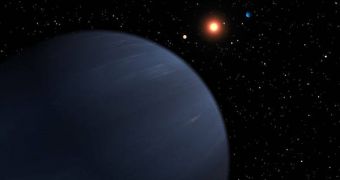Just one day after astronomers reported in a scientific journal that they had discovered a planet orbiting backwards around its star, as in spinning opposite of the star's spin, another team published evidence of another such occurrence, in a different place altogether. The new exoplanet was found by Japanese experts at the National Astronomical Observatory, operating the Subaru telescope. The body has been aptly called HAT-P-7b, and is located at a distance of about 1,000 light years from Earth. Together with the previously discovered WASP-17B, they are the only known exoplanets to exhibit such an odd behavior, New Scientist informs.
The new object was also observed via the newly launched Kepler Space Telescope, which has been specifically designed to be able to pick up signatures coming from exoplanets about the size of Earth. The planet was in fact discovered by two teams, although they reached slightly different conclusions in their investigations. The first one, from the Massachusetts Institute of Technology (MIT), was led by expert Joshua Winn, also the author of the ensuing study, while the second one was from the NAO, Japan, led by Norio Narita.
According to Winn's conclusions, HAT-P-7b either revolves around its star at a tilt of about 180°, or it orbits the star's poles, at a 90° tilt. In any case, it was found to have a wildly tilted orbit, when compared to its star's equator. “We don't know if it's a slowly rotating star that we're seeing edge-on, or a really rapidly rotating star that we're seeing pole-on. It could be like the solar system – but reversed, or it could be going pole over pole. Either way it's cool,” Winn says. Further observations from Kepler could solve this mystery, as the observatory can resolve sunspot movements on the star.
On the other hand, the Japanese group argues that the planet's orbit is inclined at a 227° angle to the stellar equator, which is a 45° difference from the results of the American team. Winn says that the difference is so significant that he cannot account for it right now. Princeton University astronomer Adam Burrows, who had nothing to do with the new investigations, says that “It's not uncommon for these measurements to be difficult enough for there to be ambiguity.” The difference, Winn says, could reside in the models the two teams used to interpret the readings they got off their respective telescopes.
“I think it's just a small systematic error that is leading to the difference. I think the take-home message is that both of the analyses are suggesting that you've got quite likely a retrograde planet. The quality of the data is still slightly noisy. I think after they get a few more measurements, the discrepancy will be cleared up,” adds Greg Laughlin, University of California in Santa Cruz (UCSC) expert. “At least both data sets are pointing to the same qualitative conclusion, that the thing is tilted quite a bit. The maximum tilt for planets in our solar system is 7°,” Winn concludes.

 14 DAY TRIAL //
14 DAY TRIAL //